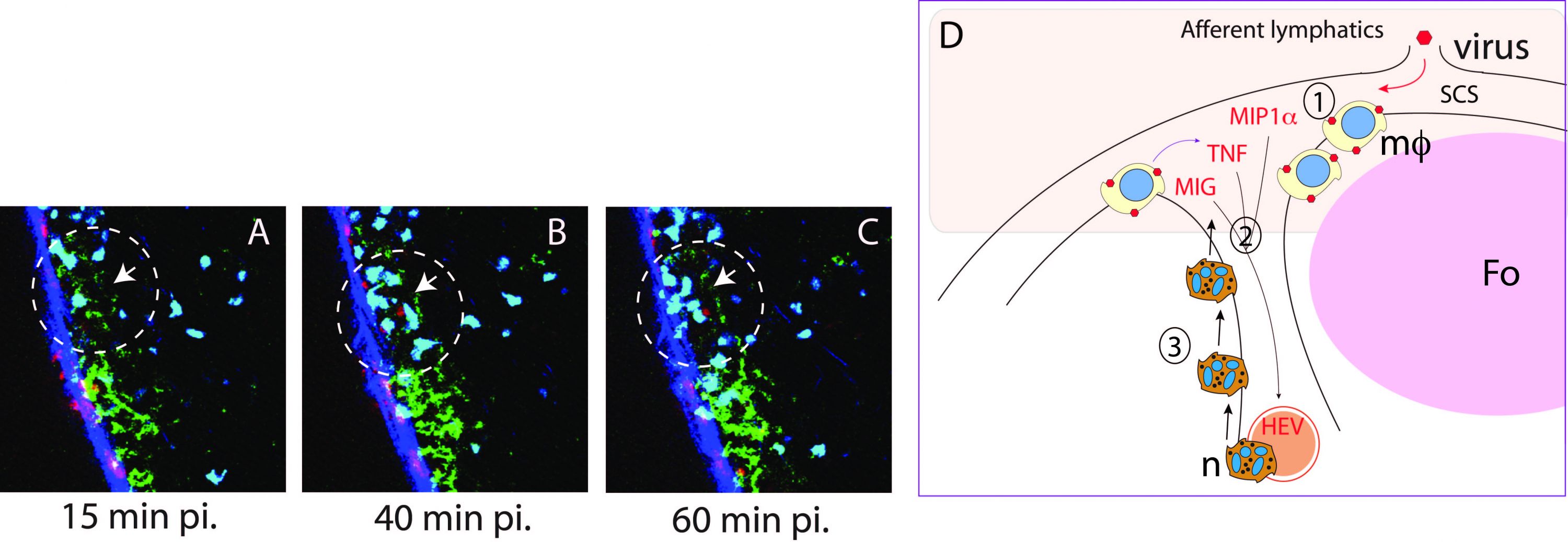Menu


Group Leader: Santiago F. González
Researchers: Juliana Falivene, Irene Latino, Daniel Molina Romero, Miguel Palomino, Diego Pizzagalli, Alain Pulfer, Tommaso Virgilio
The primary focus of my lab is to study the interface between pathogen and host. The main areas of my research interest include the innate and adaptive immune responses to respiratory pathogens, and the mechanisms by which such viruses and bacteria fight the host immune system. The initial response of the body to infection involves a series of events characterized by the rapid up-regulation and recruitment of effectors molecules and cells, which facilitate the elimination of the pathogen and the restoration of homeostasis. However, this response is not unidirectional. The pathogen has developed complex strategies to initially challenge the immune system of the host but also to resist successfully its counter attack. A better understanding of the virulence mechanism of the pathogen will contribute to the development of new strategies directed to fight the infection. In addition, the initial mechanisms in the host response directed to contain the infection will be studied. The combination of the two previous perspectives will contribute to the better understanding of the immune response to the disease challenges, allowing the design of more effective ways to enhance the host immune response.
We are currently using state-of-the-art imaging techniques such as 2-photon intravital microscopy, and confocal microscopy to address some of the aforementioned questions. These techniques enable the study of the interaction between the pathogen and the host in a completely new dimension, monitoring the cell-to-cell and microbe-to-cell interaction in real time. In addition, we will use some classic imaging techniques, such as electron and scanning microscopy, in order increase the resolution and structural information of the infected tissue or cell.
Biomedical databases are essential to feed research in the era of data-science. To this end, the group provided to the scientific community (paper) the first database of immune cell movements captured by 2-photon intravital microscopy.
Imaging experts from 7 international research groups collaborated to capture and track several types of cells in broad experimental conditions.
Below: photon intravital microscopy video capturing the migration of neutrophils in the lymph node.
Projects
Group leaders: Santiago F. González
Status: In progress
Vaccination against influenza confers in most of the cases protection against the disease. However, the current vaccines are hampered by the need of yearly vaccinations in order to protect against new circulating variants of the virus. Another important limitation of the current influenza vaccines is the development of a suboptimal immunogenicity in the elderly, in patients with chronic diseases, the immunocompromised and in young children, which correlates with higher morbidity and mortality in these risk groups. The aim of this project is to study the relevance of the inflammatory reaction induced by influenza vaccines in the lymph node. I propose to evaluate the effects that inflammation has on the previously described mechanism of capture and transport of the viral particles from the injection site to the B cell follicle. Understanding the mechanism of action of the influenza vaccine will enable the manipulation of the immune response in order to induce a strongly immunogenic, safer and protective response through vaccination. Moreover, this knowledge is expected to improve other vaccine models, thus benefiting the field of vaccination.
Group leaders: Santiago F. González Status: In progress
Despite their abundance and physiological importance not much is known about the role of the neutrophils in the lymph node. Different studies have indicated their important function as major effector cells in controlling infections caused by different types of pathogens. Their mechanism of action is based on the secretion of cytokines and the generation of reactive oxygen species and/or microbiocidal peptides directed towards the pathogen. In addition, some studies have suggested a regulatory role, affecting CD8 T cell priming or interacting with dendritic cells (DC). Interestingly, a recent study has observed a competitive role for the antigen between the neutrophils and the antigen presenting cells (macrophages and DC) in the lymph node. In this work, the authors conclude that neutrophils have an important negative role in the CD4 T cell and B cell responses to three protein antigens: hen egg white lysozyme, ovoalbumin and listeriolysin. In a pilot study we observed that the injection of influenza virus was accompanied with a significant increase of infiltrated neutrophils in the subcapsular sinus area of the drained lymph node. Interestingly, we observed that the infiltrated neutrophils were located in the proximity of the subcapsular sinus macrophages. The aim of this project is to characterize the migration patterns of the infiltrated neutrophils in vivo in the lymph node using different infectious models. In addition, we will evaluate the relevance of this cell type in the initiation of the protective response against different pathogens. To achieve this goal we will use Intravital 2-photon-laser microscopy.

Photon intravital microscopy snapshots of infiltrated neutrophils (blue) in the SCS area associated subcapsular sinus macrophages (green). Neutrophils accumulate into the SSM area using a swarming mechanism. (D), Schematic model showing the recruitment of neutrophils in the SCS area.

Via Vincenzo Vela 6
6500 Bellinzona, Switzerland
Tel. +41 91 820 0300
Fax +41 91 820 0302
Facebook / Twitter
